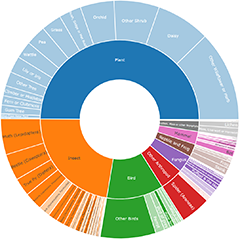Other caps, gills below, no stem
The fungi in this sub-group have caps with smooth to slightly roughened upper surfaces. The cap surfaces are not furry, though there may be a slight furriness near the attachment point. On the underside there may be some forking of gills or occasional weak veins between them but radial gills are clearly dominant. The fungi in most of the genera in this group produce white spore prints.
In the following hints you see examples of useful identification features and a few of the more commonly seen genera in which at least some species (not necessarily all) show those features.
Hints
Brown spore print: Crepidotus, Tapinella.
Pink spore print: Entoloma.
Orange to red caps: Anthracophyllum.
On soil amongst mosses: Arrhenia.
On woodchip mulch: Tapinella.
On the underside of dead wood, with the top of the cap attached to the wood: Resupinatus.
With serrated gill edges (much like a saw blade): Lentinellus.
Glows in the dark: Omphalotus.
Cap at least partially gelatinized: Hohenbuehelia.
Warning
The gelatinization in Hohenbuehelia may disappear in dry weather.
Announcements
There are currently no announcements.
Discussion
zz Agaric (stemless)
zz Agaric (stemless)
zz Agaric (stemless)
Top contributors
- KenT 19
- trevorpreston 14
- Teresa 11
- Hejor1 9
- FionaG 8
- purple66 3
- Heino1 3
- natureguy 3
- CanberraFungiGroup 3
- TimL 3
Top moderators
- Heino1 34
- Heinol 26
- Pam 11
- KenT 9
- Heino 8
- Teresa 7
- MichaelMulvaney 4
- CanberraFungiGroup 2
- Csteele4 1
- PandaLemon 0




